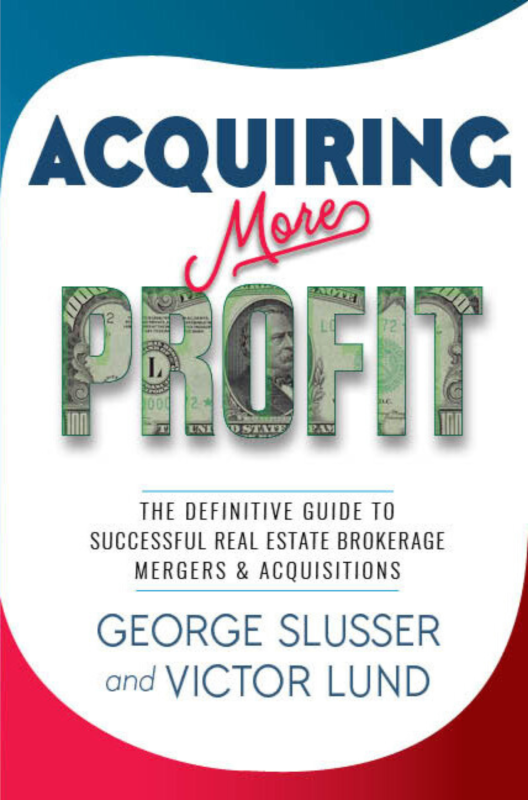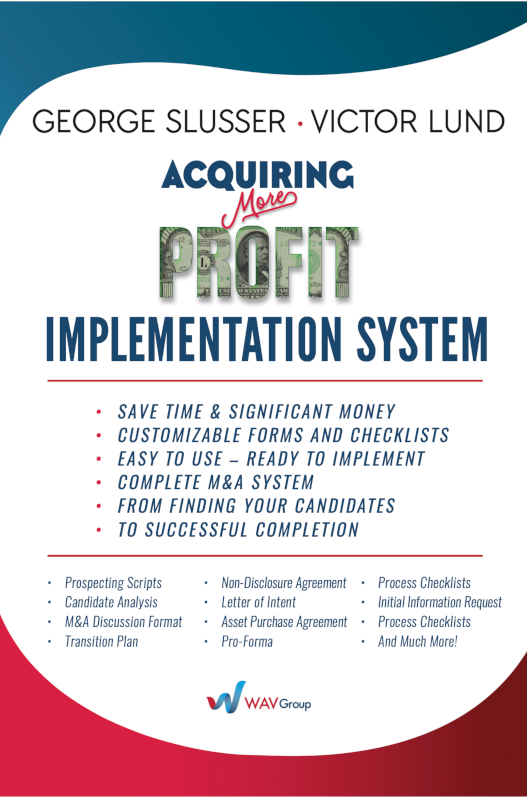You are viewing our site as a Broker, Switch Your View:
Agent | Broker Reset Filters to Default Back to ListThe 11 Positive Side Effects of Brokerage M&A Stimulates Financial and Operational Growth
March 21 2024
 The title of WAV Group's book exemplifies the purpose of brokerage mergers and acquisitions, Acquiring More Profit. Successful mergers stimulate more transaction volume and profit for the firm, but there are many positive side effects that are often under-appreciated. Since publication, WAV Group has had the opportunity to collaborate with many of our clients to discuss the 11 positive side effects of successful M&A. Today, we'll outline how these 11 side effects stimulate financial and operational growth.
The title of WAV Group's book exemplifies the purpose of brokerage mergers and acquisitions, Acquiring More Profit. Successful mergers stimulate more transaction volume and profit for the firm, but there are many positive side effects that are often under-appreciated. Since publication, WAV Group has had the opportunity to collaborate with many of our clients to discuss the 11 positive side effects of successful M&A. Today, we'll outline how these 11 side effects stimulate financial and operational growth.
1. Intense focus on change
There is an enormous amount of preparation that goes into a successful merger or acquisition. The process of discovery researching into the deep operational bowels of another brokerage will often yield new innovative approaches to improving your business. The process of evaluating if an acquisition strategy is right for you will drive an internal exploration of your own competencies, strengths, wants and needs.
2. Process documentation
Every brokerage has developed operational processes. In WAV Group's findings, firms with fewer than 350 agents rarely have their processes documented. This can be particularly harmful in a merger because it makes it much more difficult to train managers and agents on how the firm operates. As a result, processes are defined ad hoc by agents who want to do things the way they have always done things, or managers implement processes at the branch level that vary from branch to branch. Proper process documentation by both firms in a merger allows the companies to evolve their processes to blend the best practices of each firm together and improve the overall effectiveness of the combined entity.
3. Improved onboarding and offboarding
Firms with more than 100 agents typically have a checklist for onboarding a new agent. In addition to the many documents that need to be signed, there are introductions that need to be made to support staff, and probably about 22 software applications that need to be configured to the new agent. Often, a successful onboarding experience will validate the agent's decision to join you and become a productive long term asset.
Most firms do a pretty decent job of onboarding, but fail to have a documented process for offboarding. What are all of the things that need to be shut off when an agent leaves the firm? WAV Group audits brokerages regularly to align software licenses to shut off applications that they are continuing to pay for agents who have left the firm, shut off agent IDX agreements, etc. During a merger, the firm is onboarding a horde of agents. Proper planning and documentation will allow this process to happen smoothly and delight the agents joining the firm with little or no disruption to their selling efforts.
4. Growth
There are enormous economies of scale that can happen in a growing real estate company. Many operational expenses are not linear with the number of agents or transactions. Most firms have excess capacity in their fixed expenses which could be spread over many more agents. Often growth will drive down the cost of business and press the efficiency of underutilized company assets like offices and staff.
Companies like Homesmart have created technologies that even support remote office staff. For example, the home office has a team of receptionists who pop up on a screen like a Zoom call when anyone enters the office. They greet the guests on video and either page an agent or help the visitor with anything they need. This process allows a receptionist to greet anyone entering any office any time. There are many other examples of this.
The ability to maximize the efficiency of the firm's services to a wider net of agents and clients often produces efficacies of scale. Transaction management, commission management, training, and other regular activities of the brokerage are often underutilized, and the growth of the firm can be supported without additional staffing.
5. Value creation
Every firm in real estate is competing amid significant disruption and uncertainty. The scale of a firm in a given market will cast a bright light of industry leadership against mounting margin pressures and the determined efforts to realign costs to sustain market share and profitability.
Firms who are active in M&A are constantly strengthening their competitive positioning with smart cost decisions to preserve profits and enable further investment in growth through acquisitions. Firms who view their business value in light of the capital value of their company are often the most efficient managers of expenses and capital.
6. Offset taxes through reinvestment
Most brokerage firm owners take a minimum salary to optimize the profits of the firm. At the end of the year, the firm either pays profits out to the shareholders as dividends or pays corporate tax to keep the money in the company for operating expenses. Another efficient way to manage the tax implications of profits is to reinvest operating profit into acquisitions. Losses from one company offset profits in another company. As a result of properly adhering to the tax code, firms can reinvest profits into growth and benefit from the tax savings.
7. Reassess management team and function
Every good manager has a superpower. Some are great at training, others are great deal-doctors, some outperform their peers at recruiting, and more. Expanding the company provides an opportunity for management realignment that allows the firm to put the best players on the field in the position that they thrive in. There is nothing more beneficial in a merger than picking up additional management that is equal to or better than your existing staff. This is often called an acquihire – merging the words acquisition and hire into one word.
8. A playbook is an asset
 WAV Group works with many brokerages to create an acquisition playbook. This is a customized document that is based upon the acquisition checklists that are included in the Implementation System to Acquiring More Profit. (BTW, if you purchase the Implementation Guide, be sure to purchase the electronic version where we will deliver the editable Word and Excel docs that comprise the Implementation Guide. This allows you to customize the checklists to align with your organization.)
WAV Group works with many brokerages to create an acquisition playbook. This is a customized document that is based upon the acquisition checklists that are included in the Implementation System to Acquiring More Profit. (BTW, if you purchase the Implementation Guide, be sure to purchase the electronic version where we will deliver the editable Word and Excel docs that comprise the Implementation Guide. This allows you to customize the checklists to align with your organization.)
Having a process that is documented and refined with each merger allows a firm to get increasingly better at mergers. The same is true for opening new offices. Having a list of everything that needs to be done and the assignment of tasks to the people who will take on the tasks is a keynote of preparedness that allows companies to consistently have successful merger outcomes. Moreover, if an opportunity arises quickly when a broker comes to you with an immediate merger need, you will be ready. Leading companies like Compass, Howard Hanna, HomeServices of America, United Realty, and many others have made acquisitions a repeatable science in their business.
9. Expand business units
If you look in the rear view mirror to determine how companies maximize financial and operational growth through mergers and acquisitions, you find that the greatest amount of success is delivered through the expansion of business units. Real estate brokerages often have a variety of affiliated businesses that also benefit from the merger of brokerages. For example, at Watson Realty they have business units in mortgage, title, insurance, new home, property management, relocation, along with home service companies like plumbing, electric, landscaping, etc. Companies that merge with Watson not only benefit from their operational expertise and brand, but enable additional consumer services that drive additional margin to the company.
10. Grow firm value
Whenever WAV Group speaks to brokers about mergers and acquisitions, the top question is what multiple of profit are companies trading at today. Our answer is always a range – 3x to 7x profit. But that is a small part of the answer. Many times, a company can be unprofitable but growing at a remarkable pace. For example, Compass is currently valued at $1.7B but has rarely demonstrated an operating profit. Even if your brokerage is not profitable, it has value. Last year, a client of ours did an acquisition where the seller brought a check to the closing table. The overall observation made by WAV Group over the past decade is that larger firms trade at a higher value than smaller firms. A company that is operating in the top-third in an area's market share is worth more than a small firm operating in the bottom-third. Rolling up a bunch of small firms in a market to create a large firm is a great strategy for using growth to improve the value of a business.
11. Shared services
Many real estate companies have staff who are jacks-of-many-trades, masters of none. As firms grow, they are able to dedicate staff members to single roles rather than multiple roles. Rather than have multiple staff members responsible for a variety of operational activities, those staff members can be dedicated to fewer activities across a wider organization. It is vital that these opportunities for shared services are explored before and after a merger to streamline the organization and eliminate duplicate and inconsistent work.
As you can appreciate, mergers create many important side effects to improve the performance of a brokerage firm beyond increased market share, transaction volume, and profit. Be sure to purchase a copy of Acquiring More Profit and our Implementation Guide to get started on your M&A journey.
If you need a valuation on your company, if you are thinking of selling, or there is a company that you would like to buy, please reach out to us to schedule a confidential discussion. We will immediately schedule a discovery meeting.
To view the original article, visit the WAV Group blog.









